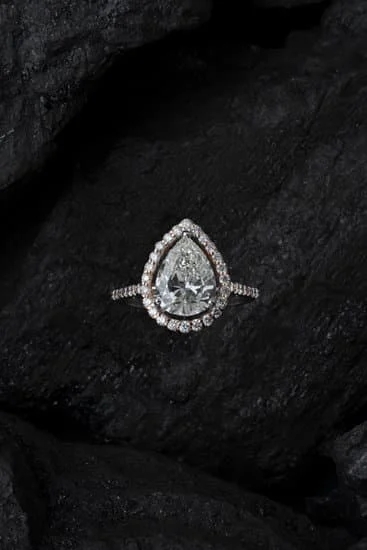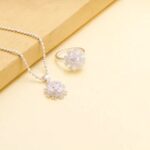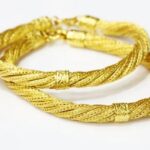When it comes to jewelry, small diamonds can add a touch of elegance and sparkle. However, there may come a time when these precious gemstones need to be removed from your pieces. Whether it’s for repair, re-designing, or simply changing the look of your jewelry, knowing how to safely remove small diamonds is essential.
Small diamonds can be found in various types of jewelry, including rings, necklaces, earrings, and bracelets. These delicate gemstones are often used as accents or fillers to enhance the overall aesthetic appeal. However, over time or due to accidental damage, these diamonds can become loose or stuck within the jewelry setting.
To successfully remove small diamonds without causing further harm or compromising the integrity of the piece requires some preparation and the right tools. Gathering essential supplies and equipment is crucial to ensure a safe removal process that minimizes the risk of damage.
Assessing the condition of your jewelry is also an important step before attempting to remove any small diamonds. Identifying loose or stuck diamonds will help you determine which method of removal would be most suitable for your specific situation. By following proper techniques and taking necessary precautions, you can effectively preserve both the beauty of your jewelry and its precious stones while safely removing those smaller diamonds.
Types of Jewelry with Small Diamonds
Small diamonds can be found in a variety of jewelry pieces, and it is important to identify the different types of jewelry that may have small diamonds stuck or loose. By understanding the types of jewelry that commonly contain small diamonds, you can better assess whether they need to be removed or repaired.
Here are some common types of jewelry that often have small diamonds:
- Rings: Rings are one of the most popular types of jewelry that include small diamonds. Whether it’s an engagement ring, wedding band, or a fashion ring, small diamonds are frequently used as accents or as the center stone. Prong-set rings are more prone to having small diamonds become loose over time.
- Earrings: Earrings are another common type of jewelry that may have small diamonds. They can be in the form of studs, hoops, drop earrings, or even earcuffs. It’s important to regularly check the settings and stones on earrings to ensure they remain secure.
- Necklaces and Pendants: Necklaces and pendants can also incorporate small diamond accents for added sparkle. These pieces are often delicate and require special attention when removing any stuck or loose diamonds.
- Bracelets: Bracelets such as tennis bracelets and bangles may feature small diamonds set in a row or as individual charms. The movement and everyday wear of bracelets can lead to loosening of stones over time.
Now that you know the different types of jewelry that may have small diamonds stuck or loose, it is essential to gather the necessary tools and preparations needed before attempting any removal methods.
Preparations and Tools Required
Removing small diamonds from jewelry requires the use of specific supplies and equipment to ensure a safe and successful process. It is important to gather all the necessary tools before attempting to remove the diamonds, as this will make the task more efficient and prevent any damage to the jewelry.
One essential tool for removing small diamonds is a set of precision tweezers. These tweezers have pointed tips that allow for delicate manipulation of the diamonds without causing any harm to them or the surrounding jewelry. It is important to choose tweezers that are made of non-reactive material, such as stainless steel, to avoid any chemical reactions with the diamonds.
Another helpful tool is a jeweler’s loupe or a magnifying glass. These tools provide enhanced visibility and allow for better assessment of the diamonds’ position and condition. By using a loupe or magnifying glass, you can identify if the diamonds are loose or stuck in their settings, which will determine the proper removal method.
Additionally, having a soft cloth or velvet pad on hand is useful for creating a safe work surface. This will prevent any scratches or damage to the jewelry while you are working on it. Placing the jewelry on a soft cloth also ensures that it doesn’t slip or move around during the removal process.
Lastly, adhesive solutions such as rubbing alcohol or acetone may be required in certain cases where glue or residue needs to be dissolved before removing small diamonds. These solutions help loosen any adhesive that may be securing the diamond in place and make it easier to detach without causing damage.
In summary, when preparing to remove small diamonds from jewelry, it is important to have essential supplies and equipment at your disposal. Precision tweezers, a jeweler’s loupe or magnifying glass, a soft cloth or velvet pad, and adhesive solutions are key tools for safely removing small diamonds without causing any harm. By having these tools ready beforehand, you can streamline the removal process and ensure the integrity of the jewelry.
Assessing Damage
When it comes to removing small diamonds from jewelry, it is important to first assess the damage and identify whether the diamonds are simply loose or if they are stuck. This will help you determine the best removal method to use, ensuring that you do not cause further damage to the jewelry.
To identify loose diamonds, carefully inspect your jewelry under good lighting. Gently shake or tap the piece to see if any diamonds move or make a rattling sound. If there is noticeable movement or noise, it indicates that one or more of the diamonds are loose and could potentially fall out. In this case, it is crucial to take action quickly to prevent loss.
On the other hand, identifying stuck diamonds requires more careful observation. Look for any signs of dirt, debris, or residue around the diamond setting. This can indicate that glue or another adhesive was used to secure the diamond in place. Additionally, try gently wiggling the diamond with your fingers or using a pair of tweezers. If there is no movement at all, it is likely that the diamond is stuck.
Once you have determined whether the diamonds are loose or stuck, you can then decide on the best removal method. If they are loose, non-invasive techniques such as gentle manipulation and using magnifying tools can be effective in safely removing them without causing any damage. These methods allow for precise control and minimize the risk of accidentally dislodging other stones.
If the diamonds are stuck due to adhesive residue, using adhesive solutions can be an effective approach. There are specialized solvents available that safely dissolve glue without harming the jewelry itself. It is important to follow instructions carefully and use these solvents sparingly so as not to damage any surrounding materials.
In some cases, particularly if you are unsure about how to proceed or if valuable pieces are involved, seeking professional assistance from a jeweler may be the best option. Jewelers have the knowledge, experience, and specialized tools to safely and effectively remove small diamonds without causing damage to the jewelry.
By carefully assessing the damage and identifying whether the diamonds are loose or stuck, you can determine the most appropriate removal method. Whether you choose to handle it yourself or seek professional help, it is important to approach the process with caution and care in order to preserve the integrity and beauty of your jewelry.
Method 1
When it comes to removing small diamonds from jewelry, non-invasive techniques are often the first method to try. These methods involve gentle manipulation and the use of magnifying tools to safely remove the diamonds without causing any damage to the jewelry or stones.
One non-invasive technique involves using tweezers or a jewelry pick to gently nudge the diamond back into place or remove it completely. It is important to be extremely careful while doing this, as applying too much pressure or using inappropriate tools can scratch or chip the diamond or even damage the entire piece of jewelry.
Another helpful tool for this method is a jeweler’s loupe or magnifying glass, which can make it easier to see and manipulate small diamonds. The magnification aids in identifying any obstructions, such as dust, that may be preventing the diamond from moving freely. Using a soft brush or compressed air can help remove any debris trapped around the diamond before attempting gentle manipulation.
| Gentle Manipulation Techniques | Magnifying Tools |
|---|---|
| Using tweezers or a jewelry pick | Jeweler’s loupe or magnifying glass |
| Being cautious not to apply too much pressure | Aiding in identifying obstructions and debris |
| Possible risk of scratching or chipping | Avoiding potential damage during removal process |
It is crucial to note that non-invasive techniques should only be attempted if you are confident in your skills and have experience working with jewelry. If you are unsure or uncomfortable, it is always advisable to seek professional assistance from a jeweler who specializes in diamond settings.
In the next section, we will explore another method that involves using adhesive solutions to dissolve glue or residue and detach small diamonds from jewelry. This can be particularly useful for situations where the diamond is firmly stuck due to adhesive used during manufacturing or repair processes.
Method 2
When small diamonds become stuck in jewelry due to adhesive residue, using an adhesive solution is an effective method to safely remove them. Adhesive solutions work by dissolving the glue or residue that is holding the diamonds in place, allowing them to be detached without causing any damage to the jewelry itself.
To begin this method, you will need a few essential supplies: a cotton swab or soft-bristle toothbrush, a small container for the adhesive solution, and the appropriate adhesive solvent for your specific type of jewelry. It is important to note that different adhesives require different solvents, so carefully read the instructions on the solvent packaging and ensure it is safe for use on your particular piece of jewelry.
Firstly, place some of the adhesive solution into the small container. Then, dip the cotton swab or soft-bristle toothbrush into the solution and apply it gently onto the glued area where the small diamond is stuck. Be cautious not to use excessive force while applying the solution as it may cause damage to both the diamond and the rest of the jewelry.
Allow sufficient time for the adhesive solution to work its magic and dissolve the glue. The length of time required will vary depending on both the type of glue and solvent used. It is advisable to periodically check if any progress has been made before proceeding further.
Once you notice that some progress has been made and that the glue has started to break down, delicately try moving or wiggling the small diamond with a pair of tweezers. Take extra care when doing this step as too much force can still potentially cause damage.
If you are unable to remove the diamond immediately, repeat this process until enough glue has dissolved for it to come loose easily. Patience is key during this method as rushing could lead to unintentional harm.
By utilizing adhesive solutions to safely dissolve glue or residue, you can effectively detach small diamonds from jewelry without causing any damage. This method is ideal for situations where the diamonds have become stuck due to previous repairs, bent prongs, or any other circumstance involving adhesive residue. However, it is essential to proceed with caution and follow the instructions provided with the adhesive solvent to ensure the best possible outcome.
Method 3
When it comes to removing small diamonds from jewelry, sometimes it is best to seek professional assistance. There are certain situations where the expertise of a jeweler can ensure the safe removal of these precious gems without causing any damage to the jewelry piece itself. Here, we will explore when and how to seek help from a jeweler for removing small diamonds.
- Assessing the Complexity: Before deciding whether to seek professional assistance, it is important to assess the complexity of the task at hand. If the jewelry piece contains intricate settings or complicated designs, it may be challenging to remove small diamonds without proper tools and knowledge. In such cases, reaching out to a jeweler who specializes in diamond removal is highly recommended.
- Specialty Jewelers: Not every jeweler has expertise in diamond removal, so it is essential to find one who does. Look for jewelers who have experience working with small diamonds and are knowledgeable about different types of settings. You can ask for recommendations from friends, family, or even search online for reputable jewelers in your area.
- Consultation: Before entrusting your precious jewelry to a jeweler, schedule a consultation where you can discuss your concerns and inquire about their experience in diamond removal. During this consultation, make sure to ask about their techniques and equipment used for removing small diamonds. It is also crucial to inquire about any damage that could potentially occur during the removal process and if they offer any guarantees or insurance coverage.
- Pricing: The cost of professional diamond removal can vary depending on factors such as the complexity of the task, the size and number of diamonds involved, and the reputation of the jeweler. It is advisable to get quotes from multiple jewelers before making a decision. However, remember that quality craftsmanship should take precedence over cost, as improper removal can lead to irreparable damage to the jewelry piece.
Overall, seeking professional assistance from a specialized jeweler is an excellent option when it comes to removing small diamonds from jewelry pieces with complex designs and settings. Their expertise will ensure that the diamonds are removed safely and without causing any harm to the jewelry. Remember to thoroughly research and consult with different jewelers before making a decision, and prioritize quality craftsmanship over cost.
Post-Removal Care
After successfully removing small diamonds from jewelry, it is important to take certain steps to ensure the integrity of the piece. Post-removal care is crucial in order to preserve the beauty and functionality of the jewelry. Below are some recommended steps to follow:
Clean and Polish
Once the small diamonds have been removed, it is a good idea to clean and polish the jewelry. Use a soft cloth or a jewelry cleaning solution specifically designed for the type of metal and gemstones in your piece. Gently wipe away any residue that may have been left behind during the removal process. Polishing the jewelry will help restore its shine and luster.
Inspect for Damage
After removing the small diamonds, carefully inspect the jewelry for any damage that may have occurred during the removal process. Check for loose prongs, bent metal, or any other visible signs of wear and tear. If you notice any issues, it is best to take your jewelry to a professional jeweler for repair before continuing to wear it.
Jewelry Maintenance
Now that your jewelry has had its small diamonds removed, it’s important to establish a regular maintenance routine. This includes cleaning your jewelry regularly, avoiding contact with harsh chemicals or substances that could damage it, and storing it properly when not in use. Taking these preventative measures will help extend the lifespan of your jewelry and keep it looking beautiful for years to come.
By following these post-removal care steps, you can ensure that your jewelry remains in excellent condition after removing small diamonds. Taking proper care of your jewelry not only helps maintain its appearance but also protects its value as an investment. Remember to consult with a professional jeweler if you encounter any issues or concerns regarding post-removal care or if you wish to refurbish your piece after diamond removal.
DIY Tips
Proper Storage: Keeping Jewelry Secure
One of the most effective ways to prevent small diamonds from becoming stuck or loose in jewelry is proper storage. When not wearing your jewelry, it is important to store it in a safe and secure place.
Avoid tossing your jewelry into a drawer or jewelry box without any protection as this may lead to damage and diamonds becoming loose. Instead, consider using individual compartments or pouches to keep each piece separate and protected from scratching or tangling with other jewelry.
Regular Inspection: Checking for Loose Diamonds
Regularly inspecting your jewelry can help you identify any potential issues before they become bigger problems. Take the time to carefully examine your pieces, paying close attention to the settings holding the diamonds. Look for signs of wear, such as bent prongs or clasps that may need repair. By catching these issues early on, you can prevent small diamonds from becoming loose or detaching from their settings.
Professional Cleaning and Maintenance: Trusting the Experts
While home maintenance plays an important role in preserving your jewelry, there are certain tasks that are best left to professionals. It is recommended to have your jewelry cleaned and inspected by a jeweler at least once a year. Professionals have the necessary tools and expertise to clean and maintain your jewelry without causing damage. During these routine visits, jewelers can also check for loose diamonds and tighten any settings that may be compromised.
Taking Precautions During Activities: Protecting Your Jewelry
Certain activities can put unnecessary strain on your jewelry and increase the risk of small diamonds coming loose or getting stuck. It is advisable to remove your jewelry before engaging in activities such as exercising, swimming, gardening, or any other physical activities that could potentially damage it. Additionally, it is important to avoid exposing your jewelry to harsh chemicals or excessive heat, as this can weaken the settings and cause diamonds to become loose.
Regular Maintenance: Reassessing Jewelry and Settings
Lastly, regular maintenance is key to preventing small diamonds from becoming stuck or loose in your jewelry. Take the time to reassess your pieces periodically, especially if you have experienced any changes in the settings or notice any signs of wear. By being proactive and addressing any potential issues promptly, you can ensure that your jewelry remains beautiful and secure for years to come.
By following these DIY tips for preventing small diamonds from becoming stuck or loose in your jewelry, you can maintain the integrity and beauty of your precious pieces. Taking proper care of your jewelry not only protects its value but also allows you to enjoy wearing it with confidence.
Remember to always be proactive when it comes to maintenance and seek professional help when necessary. With these tips in mind, you can keep your small diamonds safely in place and showcase their brilliance for generations to come.
Conclusion
In conclusion, removing small diamonds from jewelry requires careful preparation, the right tools, and a gentle approach. It is essential to identify the different types of jewelry that may have small diamonds stuck and assess any damage before proceeding with removal. Methods such as non-invasive techniques, adhesive solutions, and seeking professional assistance can all be effective in safely removing small diamonds.
After successfully removing the diamonds, it is important to take post-removal care to ensure the integrity of the jewelry. This includes carefully inspecting the piece for any damage or residue left behind and taking appropriate steps to clean and polish it if necessary. By doing so, you can preserve the beauty of your jewelry and maintain its value.
To prevent small diamonds from becoming stuck or loose in the future, there are several DIY tips to keep in mind. Regularly inspecting your jewelry for any signs of damage or looseness is crucial, as is properly storing and handling it. Additionally, having your jewelry professionally cleaned and checked on a regular basis can help prevent any issues with small diamond removal down the line.
Ultimately, successfully removing small diamonds from jewelry requires patience, attention to detail, and sometimes professional assistance. By following the outlined steps and implementing preventive measures, you can ensure that your precious stones remain secure and your jewelry continues to shine for years to come.
Frequently Asked Questions
What can I do with a bunch of small diamonds?
A bunch of small diamonds can be used for various purposes, depending on your preferences and creativity. One option is to create a stunning diamond cluster ring or pendant by arranging the small diamonds closely together to give the appearance of one large stone. Another idea is to incorporate them as accent stones in jewelry designs, such as using them to embellish the band of a ring or adding sparkle to earrings or bracelets.
Furthermore, if you have enough small diamonds, they could be combined to create a unique piece of jewelry like a necklace or brooch. Alternatively, you might consider selling the small diamonds individually or as a lot if you no longer have use for them, which can potentially provide some financial return.
What do you call tiny diamonds in jewelry?
Tiny diamonds in jewelry are commonly referred to as “diamond accents.” These delicate stones are typically used in combination with a larger central stone, adding sparkle and visual interest to the overall design. Diamond accents often enhance rings, necklaces, earrings, or any other type of jewelry where shimmering details are desired.
They may be prong-set or pavé-set alongside the main gemstone or along different parts of the metalwork. While they may be individually small in size, their collective presence can contribute significantly to the beauty and aesthetic appeal of a piece of jewelry.
Do small diamonds fall out of rings easily?
Small diamonds generally do not fall out of rings easily if they have been properly set by an experienced jeweler using secure settings such as prongs or bezels. These settings help hold the stones firmly in place and prevent them from dislodging during regular wear. However, there is always some possibility that due to accidental impacts on hard surfaces or wear and tear over time, even securely set small diamonds may become loose and fall out.
To minimize this risk, it is advisable to have your jewelry inspected regularly by a professional jeweler who can check for any signs of loosening settings or potential issues that could result in lost stones. Promptly addressing any needed repairs or maintenance can help preserve the longevity and integrity of your diamond jewelry.

Welcome to my jewelry blog! My name is Sarah and I am the owner of this blog.
I love making jewelry and sharing my creations with others.
So whether you’re someone who loves wearing jewelry yourself or simply enjoys learning about it, be sure to check out my blog for insightful posts on everything related to this exciting topic!





